Biocementation as a Pro-Ecological Method of Stabilizing Construction Subsoil
Abstract
1. Introduction
2. Existing Research Findings—Searching for Alternatives and Pro-Ecological Methods for Soil Stabilization
3. Materials and Methods
- qn—net cone resistance,
- Nkt—empirical coefficient, dependent on soil characteristics.
4. Test Results
5. Discussion
6. Conclusions
Author Contributions
Funding
Data Availability Statement
Acknowledgments
Conflicts of Interest
References
- Mian, A.; Bendig, M.; Piazzesi, G.; Manente, G.; Lazzaretto, A.; Maréchal, F. Energy Integration in the cement industry. Comput. Aided Chem. Eng. 2013, 32, 349–354. [Google Scholar] [CrossRef]
- Ali, M.B.; Saidur, R.; Hossain, M.S. A review on emission analysis in cement industries. Renew. Sust. Energ. Rev. 2011, 15, 2252–2261. [Google Scholar] [CrossRef]
- Vatopoulos, K.; Tzimas, E. Assessment of CO2 capture technologies in cement manufacturing process. J. Clean. Prod. 2012, 32, 251–261. [Google Scholar] [CrossRef]
- Petroleum, B. Statistical Review of World Energy; BP: London, UK, 2009. [Google Scholar]
- Bremner, T. Environmental aspects of concrete: Problems and solutions. In Proceedings of the 1-st All-Russian Conference on Concrete and Reinforced Concrete, Moscow, Russia, 9–14 September 2001. [Google Scholar]
- Worrell, E.; Price, L.; Martin, N.; Hendriks, C.; Meida, L.O. Carbon dioxide emissions from the global cement industry. Annu. Rev. Energy Environ. 2001, 26, 303–329. [Google Scholar] [CrossRef]
- Sherwood, P. Soil stabilization with cement and lime. In State of the Art Review; Transport Research Laboratory, HMSO: London, UK, 1993. [Google Scholar]
- Åhnberg, H.; Holm, G. Stabilization of Some Swedish Organic Soils with Different Types of Binder in Proceeding of Dry Mix Methods for Deep Soil Stabilization; Bredenberg, H., Ed.; Routledge: London, UK, 1999; pp. 101–108. [Google Scholar]
- EuroSoilStab. Development of Design and Construction Methods to Stabilize Soft Organic Soils: Design Guide for Soft Soil Stabilization; CT97-0351; European Commission, Industrial and Materials Technologies Programme (Rite-EuRam III): Brussels, Belgium, 2002. [Google Scholar]
- Maher, A.; Bennert, T.; Jafari, F.; Doglas, W.S.; Gucunski, N. Geotechnical Properties of Stabilized Dredged Material from New York-New Jersey Harbor. J. Transp. Res. Board 2004, 1874, 86–96. [Google Scholar] [CrossRef]
- Massarsch, K.R.; Topolnicki, M. Regional Report: European Practice of Soil Mixing Technology. In Proceedings of the International Conference on Deep Mixing Best Practice and Recent Advances, Stockholm, Sweden, 23–25 May 2005. [Google Scholar]
- Yasui, S.; Yokozawa, K.; Yasuoka, N.; Kondo, H. Recent Technical Trends in Dry Mixing (DJM) in Japan. In Proceedings of the International Conference on Deep Mixing-Best Practice and Recent Advances, Stockholm, Sweden, 23–25 May 2005. [Google Scholar]
- Achal, V.; Kawasaki, S. Biogrout: A Novel Binding Material for Soil Improvement and Concrete Repair. Front. Microbiol. 2016, 7, 314. [Google Scholar] [CrossRef]
- Krajewska, B.; Raczak, K. Podstawy i możliwości wykorzystania procesu biomineralizacji węglanu wapnia. Ochr. Sr. 2019, 41, 31–37. [Google Scholar]
- Provis, L.; van Deventer, J.S.J. Geopolymers: Structure, Processing, Properties and Industrial Applications; CRS Press: Boca Raton, FL, USA, 2009. [Google Scholar]
- Chien, S.; Chang-Yu, C.; Fu-Chen, O.T. Soil improvement using electro-osmotic chemical treatment with harmonic waves. In Geotechnical and Geophysical Site Characterization 4; Coutinho, M., Ed.; Taylor and Francis Group: London, UK, 2013. [Google Scholar]
- Otsuki, N.; Yodsudjai, N.W.; Nishida, T. Feasibility study on soil improvement using electrochemical technique. Constr. Build. Mater. 2007, 21, 1046–1051. [Google Scholar] [CrossRef]
- Chang, I.; Im, J.; Shin, H.D.; Cho, G.C. Biochemical soil treatment for erosion control against desertification. In Geotechnical Engineering for Infrastructure and Development: XVI European Conference on Soil Mechanics and Geotechnical Engineering; Winter, M.G., Smith, D.M., Eldred, P.J.L., Eds.; ICE Publishing: London, UK, 2015; pp. 2687–2692. [Google Scholar]
- Iqbal, D.; Wong, L.; Kong, S. Bio-Cementation in Construction Materials: A Review. Materials 2021, 14, 2175. [Google Scholar] [CrossRef] [PubMed]
- Alhawat, M.; Ashour, A.; Yildirim, G.; Aldemir, A.; Sahmaran, M. Properties of geopolymers sourced from construction and demolition waste: A review. J. Build. Eng. 2022, 50, 104104. [Google Scholar] [CrossRef]
- Uliasz-Bocheńczyk, A.; Mokrzycki, E. Emisja Dwutlenku Węgla w Przemyśle Cementowym, Polityka Energetyczna; Instytut GSMiE PAN: Krakow, Poland, 2003; Volume 6, pp. 367–375. [Google Scholar]
- Agapoulaki, G.I.; Papdimitriou, A.G.; Kandris, K.; Pantazidou, M. Permeation potential of colloidal silica for passive stabilization of liquefiable soils. In Geotechnical Engineering for Infrastructure and Development: XVI European Conference on Soil Mechanics and Geotechnical Engineering; Winter, M.G., Smith, D.M., Eldred, P.J.L., Eds.; ICE Publishing: London, UK, 2015; pp. 2201–2206. [Google Scholar]
- Gallagher, P.M. Passive Site Remediation for Mitigation of Liquefaction Risk. Ph.D. Thesis, Virginia Polytechnic Institute and State University, Blacksburg, VA, USA, 2000. [Google Scholar]
- Chiet, K.T.P.; Kassim, K.A.; Chong, S.Y. Biocementation Potential of Tropical Residue Soil Infused with Facultative Anaerobe Bacteria. Appl. Mech. Mater. 2015, 773–774, 1412–1416. [Google Scholar] [CrossRef]
- DeJong, J.T.; Fritzges, M.B.; Nüsslein, K. Microbially induced cementation to control sand response to undrained shear. J. Geotechn. Geoenviron. Eng. ASCE 2006, 11, 1381–1392. [Google Scholar] [CrossRef]
- Dhami, N.K.; Reddy, S.; Mukherje, A. Significant indicators for biomineralization in sand of varying grain size. Constr. Build. Mater. 2016, 104, 198–207. [Google Scholar] [CrossRef]
- Grabiec, A.M.; Starzyk, J.; Stefaniak, K.; Wierzbicki, J.; Zawal, D. On possibility of improvement of compacted silty soils using biodeposition method. Constr. Build. Mater. 2017, 138, 134–140. [Google Scholar] [CrossRef]
- Indriani, A.M.; Harianto, T.; Djamaluddin, A.R.; Arsyad, A. Study on Bio-cementation of Ex-coal Mining Soil as a Road Construction Material. In Advances in Sustainable Construction and Resource Management. Lecture Notes in Civil Engineering; Hazarika, H., Madabhushi, G.S.P., Yasuhara, K., Bergado, D.T., Eds.; Springer: Singapore, 2021; p. 144. [Google Scholar] [CrossRef]
- Kezdi, A.; Ladanyi, J.; Kabai, J. Compaction of transition soils. In Proceedings of the 4th International Conference on Soil Mechanics, Budapest, Hungary, 12–15 October 1971; pp. 177–185. [Google Scholar]
- Stefaniak, K. Wybrane Osady Aluwialne Jako Podłoże Budowlane i Materiał do Budowli Ziemnych. Ph.D. Thesis, Uniwersytet Przyrodniczy w Poznaniu, Poznań, Poland, 2014. [Google Scholar]
- Zhu, T.; Dittrich, M. Carbonate precipitation through microbial activities in natural environment and their potential in biotechnology: A review. Front. Bioeng. Biotech. 2016, 4, 4. [Google Scholar] [CrossRef]
- Chaparro-Acuña, S.P.; Becerra-Jiménez, M.B.; Martínez-Zambrano, J.J.; Rojas-Sarmiento, H.A. Soil bacteria that precipitate calcium carbonate: Mechanism and applications of the process. Acta Agron. 2018, 67, 277–288. [Google Scholar] [CrossRef]
- Dhami, N.K.; Reddy, M.S.; Mukherjee, A. Biomineralization of calcium carbonates and their engineered applications. Front. Microbiol. 2013, 4, 314. [Google Scholar] [CrossRef] [PubMed]
- Ivanov, V.; Chu, J. Applications of microorganisms to geotechnical engineering for bioclogging and biocementation of soil in situ. Rev. Environ. Sci. Biotechnol. 2008, 7, 139–153. [Google Scholar] [CrossRef]
- Dilrukshi, R.A.N.; Kawasaki, S. Effective use of plant derived urease in the field of geoenvironmental/geotechnical engineering. Int. J. Civ. Environ. Eng. 2016, 6, 207. [Google Scholar] [CrossRef]
- Valenzuela, E.I.; Avendaño, K.A.; Balagurusamy, N.; Arriaga, S.; Nieto-Delgado, C.; Thalasso, F.; Cervantes, F.J. Electron shuttling mediated by humic substances fuels anaerobic methane oxidation and carbon burial in wetland sediments. Sci. Total Environ. 2019, 650, 2674–2684. [Google Scholar] [CrossRef] [PubMed]
- Deb, P.; Talukdar, S.A.; Mohsina, K.; Sarker, P.K.; Sayem, S.M.A. Production and partial characterization of extracellular amylase enzyme from Bacillus amyloliquefaciens P-001. SpringerPlus 2013, 2, 154. [Google Scholar] [CrossRef]
- Grabiec, A.M.; Klama, J.; Zawal, D.; Krupa, D. Modification of recycled concrete aggregate by calcium carbonate biodeposition. Constr. Build. Mater. 2012, 34, 145–150. [Google Scholar] [CrossRef]
- Gomez, M.G.; Graddy, C.M.R.; DeJong, J.T.; Nelson, D.C.; Tsesarsky, M. Stimulation of Native Microorganisms for Biocementation in Samples Recovered from Field-Scale Treatment Depths. J. Geotech. Geoenviron. 2018, 144, 04017098. [Google Scholar] [CrossRef]
- Eberemu, A.O.; Onah, M.; Osinub, K.J. Effect of curing method on unconfined compressive strength of silty sand treated with Bacillus Megaterium. IOP Conf. Ser.: Mater. Sci. Eng. 2021, 1036, 012032. [Google Scholar] [CrossRef]
- Douglas, S.; Beveridge, T.J. Mineral formation by bacteria in natural Communities. FEMS Microb. Ecol. 1998, 26, 79–88. [Google Scholar] [CrossRef]
- Benini, S.; Rypniewski, W.R.; Wilson, K.S.; Miletti, S.; Ciurli, S.; Mangani, S. A new proposal for urease mechanism based on the crystal structures of the native and inhibited enzyme from Bacillus pasteurii: Why urea hydrolysis costs two nickels. Structure 1999, 7, 205–216. [Google Scholar] [CrossRef]
- Warthmann, R.; van Lith, Y.; Vasconcelos, C.; McKenzie, J.A.; Karpoff, A.M. Bacterially induced dolomite precipitation in anoxic culture experiments. Geology 2000, 28, 1091–1094. [Google Scholar] [CrossRef]
- Roden, E.E.; Leonardo, M.R.; Ferris, F.G. Immobilization of strontium during iron biomineralization coupled to dissimilatory hydrous ferric oxide reduction. Geochim. Cosmochim. Acta. 2002, 66, 2823–2839. [Google Scholar] [CrossRef]
- Karatas, I.; Kavazanjian, E., Jr.; Rittmann, B.E. Microbially induced precipitation of calcite using Pseudomonas denitrificans. In Proceedings of the 1st International Conference on Biogeotechnical Engineering, Delft, The Netherlands, 23–25 June 2008. [Google Scholar]
- Dejong, J.T.; Mortensen, B.M.; Martinez, B.C.; Nelson, D.C. Biomediated soil improvement. Ecol. Eng. 2010, 36, 197–210. [Google Scholar] [CrossRef]
- Burbank, M.; Weaver, T.; Lewis, R.; Williams, T.; Williams, B.; Crawford, R. Geotechnical Tests of Sands Following Bioinduced Calcite Precipitation Catalyzed by Indigenous Bacteria. J. Geotech. Geoenviron. 2013, 139, 928–936. [Google Scholar] [CrossRef]
- Hamdan, N.; Kavazanjian, E., Jr.; Rittmann, B.E.; Karatas, I. Carbonate mineral precipitation for soil improvement through microbial denitrification. In Proceedings of the Geo Frontiers 2011: Advances in Geotechnical Engineering, Dallas, TX, USA, 13–16 March 2011; ASCE Geotechnical Special Publication: Reston, VA, USA, 2011; Volume 211, pp. 3925–3934. [Google Scholar]
- Weaver, T.; Burbank, M.; Lewis, R.; Lewis, A.; Crawford, R.; Williams, B. Bio-induced calcite, iron, and manganese precipitation for geotechnical engineering applications. In Proceedings of the Geo Frontiers 2011: Advances in Geotechnical Engineering, Dallas, TX, USA, 13–16 March 2011; ASCE Geotechnical Special Publication: Reston, VA, USA, 2011; Volume 211, pp. 3975–3983. [Google Scholar]
- Bang, S.S.; Galinat, J.K.; Ramakrishnan, V. Calcite precipitation induced by polyurethane-immobilized Sporosarcina pasteurii. Enzym. Microb. Technol. 2001, 28, 404–409. [Google Scholar] [CrossRef]
- Okwadha, G.D.O.; Li, J. Optimum conditions for microbial carbonate precipitation. Chemosphere 2010, 81, 1143–1148. [Google Scholar] [CrossRef]
- Carmona, J.P.S.F.; Venda Oliviera, P.J.; Lemos, L.J.L. Biostabilization of a Sandy Soil Using Enzymatic Calcium Carbonate Precipitation. In Proceedings of the 3rd International Conference on Transportation Geotechnics, University of Coimbra, Coimbra, Portugal, 4–7 September 2016. [Google Scholar]
- Mujah, D.; Shahin, M.A.; Cheng, L. State-of-the-Art. Review of Biocementation by Microbially Iduced Calcite Precipitation (MICP) for Soil Stabilization. Geomicrobiol. J. 2016, 8, 1–14. [Google Scholar]
- Whiffin, V.S.; van Paassen, L.A.; Harkes, M.P. Microbial carbonate precipitation as soil improvement technique. Geomicrobiol. J. 2007, 24, 417–423. [Google Scholar] [CrossRef]
- Libudzisz, Z.; Kowal, K.; Żakowska, Z. Mikrobiologia Techniczna; Naukowe, P.W.N.W., Ed.; Mikroorganizmy w Biotechnologii, Ochronie Środowiska i Produkcji Żywności: Warsow, Poland, 2008; Volume 2. [Google Scholar]
- Keykha, H.A.; Asadi, A.; Zareian, M. Environmental Factors Affecting the Compressive Strength of Microbiologically Induced Calcite Precipitation-Treated Soil. Geomicrobiol. J. 2017, 34, 889–894. [Google Scholar] [CrossRef]
- Available online: www.geochemicaltranactions.com (accessed on 1 December 2022).
- Hartbottle, M.J.; Lam, M.T.; Botusharova, S.P.; Gardner, D.R. Self-healing soil: Biomimetic engineering of geotechnical structures to respond to damage. In Proceedings of the 7th 397 International Congress on Environmental Geotechnics, Melbourne, Australia, 10 November 2014. [Google Scholar]
- Janssen, J.; Di Emidio, G.; Verasteguiflores, R.D.; Bezuijen, A. Hydraulic conductivity and g pressure of GCLs using polymer treated clays to high concentration CaCl2 solutions. In Proceedings of the Geotechnical Engineering for Infrastructure and Development: XVI European Conference on Soil Mechanics and Geotechnical Engineering, Edinburgh, UK, 13–18 September 2015; Winter, M.G., Smith, D.M., Eldred, P.J.L., Eds.; ICE Publishing: London, UK, 2015; pp. 2687–2692. [Google Scholar]
- Qabany, A.; Soga, K. Effect of chemical treatment used in MICP on engineering properties of cemented soils. Géotechnique 2013, 63, 331–339. [Google Scholar] [CrossRef]
- Canakci, H.; Sidik, W.; Kilic, I.H. Bacterail Calcium Carbonate Precipitation in Peat. Arab. J. Sci. Eng. 2015, 40, 2251–2260. [Google Scholar] [CrossRef]
- Harianto, T.; Hamzah, S.; Nur, S.H.; Abdurrahman, F.; Latief, R.U.; Fadliah, I.; Waleman, A. Biogrouting Stabilization on Marine Sandy Clay Soil. In Proceedings of the International Conference on Asian and Pacific Coasts (APAC), Bali, Indonesia, 24–26 September 2013. [Google Scholar]
- van Paassen, L. Biogrout, Ground Improvement by Microbially Induced Carbonate Precipitation. Ph.D. Thesis, Delft University of Technology, Delft, The Netherlands, 2009. [Google Scholar]
- Cheng, L.; Cord-Ruwisch, R. In situ soil cementation with ureolytic bacteria by surfacepercolation. Ecol. Eng. 2012, 42, 64–72. [Google Scholar] [CrossRef]
- Robertson, P.K. Soil classification using the cone penetration test. Can. Geotech. J. 1990, 27, 151–158. [Google Scholar] [CrossRef]
- Wierzbicki, J. Ocena Prekonsolidacji Podłoża Metodami In-Situ w Aspekcie Jego Genezy. Ph.D. Thesis, Uniwersytet Przyrodniczy w Poznaniu, Poznań, Poland, 2010. [Google Scholar]
- Worth, C.P. The interpretation of in-situ soil tests. Geotechnique 1984, 34, 449–489. [Google Scholar]
- Karlsrud, K.; Lunne, T.; Kort, D.A.; Strandvik, S. CPTU correlations for clays. In Proceedings of the 16th ICSSMGE, Osaka, Japan, 12–16 September 2005; Millpress: Rotterdam, The Netherlands, 2005; pp. 693–702. [Google Scholar]
- Lunne, T.; Robertson, P.K.; Powell, J.J.M. Cone Penetration Testing in Geotechnical Practice; Blackie Academic EF Spon/Routledge Publishers: New York, NY, USA, 1997. [Google Scholar]
- Stefaniak, K. Assessment of shear strength in silty soils. Stud. Geotech. Mech. 2015, 37, 51–55. [Google Scholar] [CrossRef]
- PN-EN 13286-2 2010; Unbound and Hydraulically Bound Mixtures. Part 2: Test Methods for Laboratory Reference Density and Water Content. Proctor Compaction. CEN: Brussels, Belgium, 2010.
- Chunxiang, Q.; Jianyun, W.; Ruixing, W.; Liang, C. Corrosion protection of cement-based building materials by surface deposition of CaCO3 by Bacillus pasteurii. Mater. Sci. Eng. 2009, C 29, 1273–1280. [Google Scholar] [CrossRef]
- ISO 17892-9; Geoetchnical Investigation and Testing. Laboratory Testing of Soil. Part 8: Unconsolidated Undrained Triaxial Test. ISO: Geneva, Switzerland, 2018.
- ISO 17892-9; Geoetchnical Investigation and Testing. Laboratory Testing of Soil. Part 9: Consolidated Triaxial Compression Tests on Water Saturated Soils. ISO: Geneva, Switzerland, 2018.
- Stefaniak, K. Analysis of overconsolidation effect in alluvial subsoil using CPTU and DMT. In Advances in Soil Mechanics and Geotechnical Engineering, 2: Proceedings of the 5th International Young Geotechnical Engineers’ Conference; Millpress: Paris, France, 2013; pp. 383–386. [Google Scholar]
- Radaszewski, R.; Stefaniak, K. Oedometric tests of cohesive soils—Testing methods and their results. Archit. Civ. Eng. Environ. 2015, 8, 53–60. [Google Scholar]
- ISO 14688-2:2018; Geotechnical Investigation and Testing. Identification and Classification of Soil. Part 2: Principles for a Classification. ISO: Geneva, Switzerland, 2018.
- EC 7-1 EN 1997-1:2003; Design of Geotechnical Structures. Part 1: General Rules. EC Directive: Brussels, Belgium, 2003.
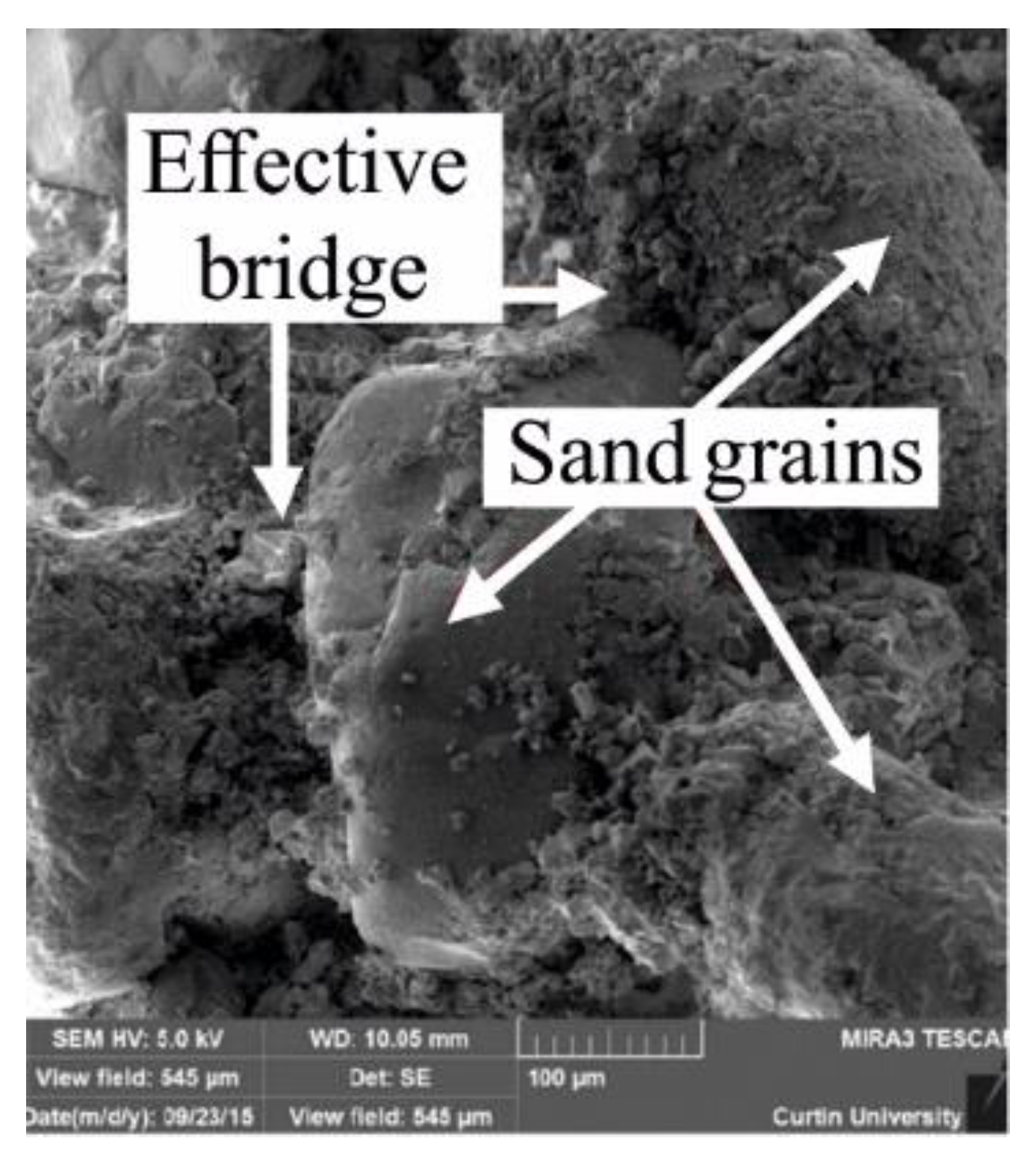

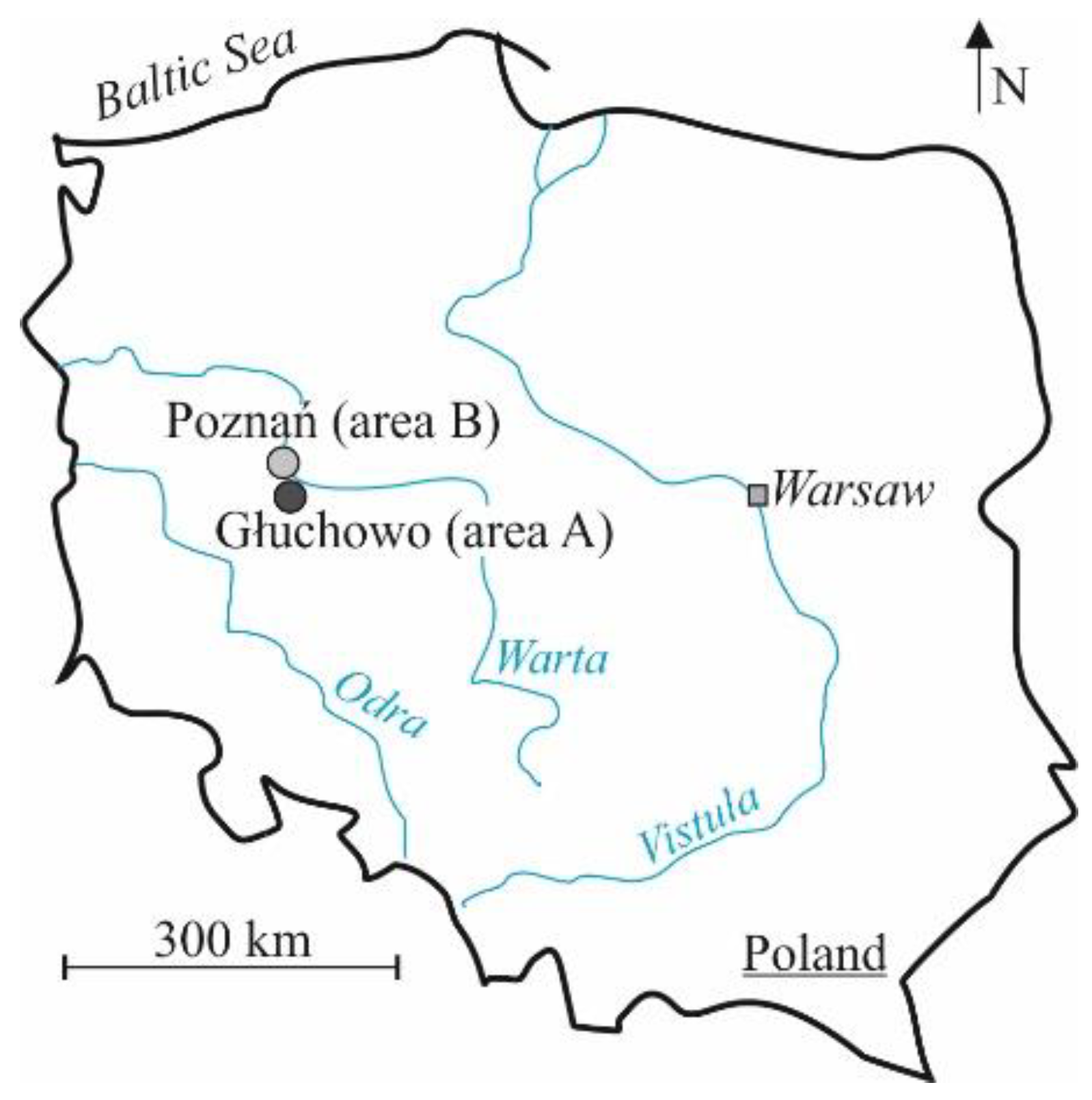

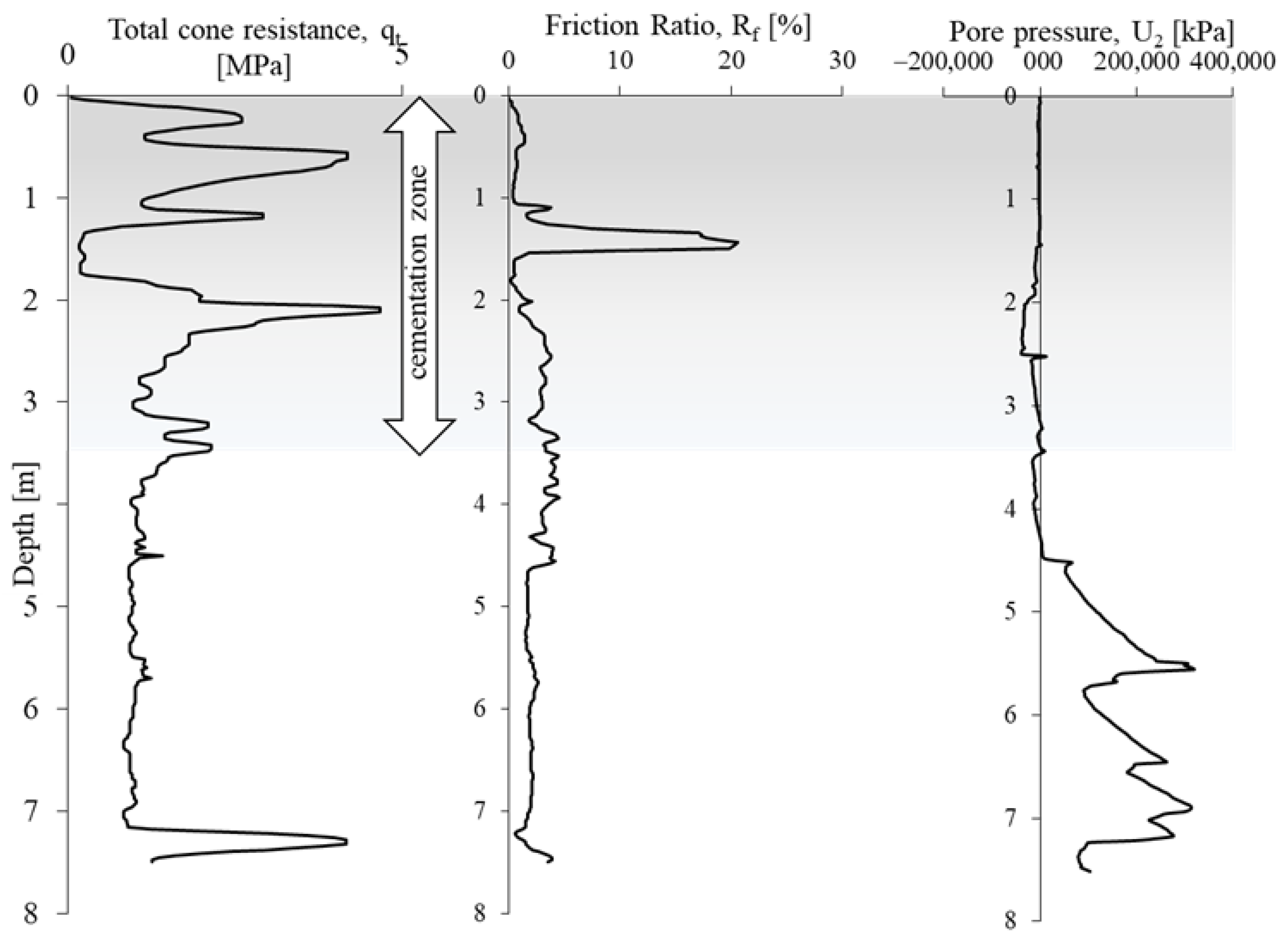
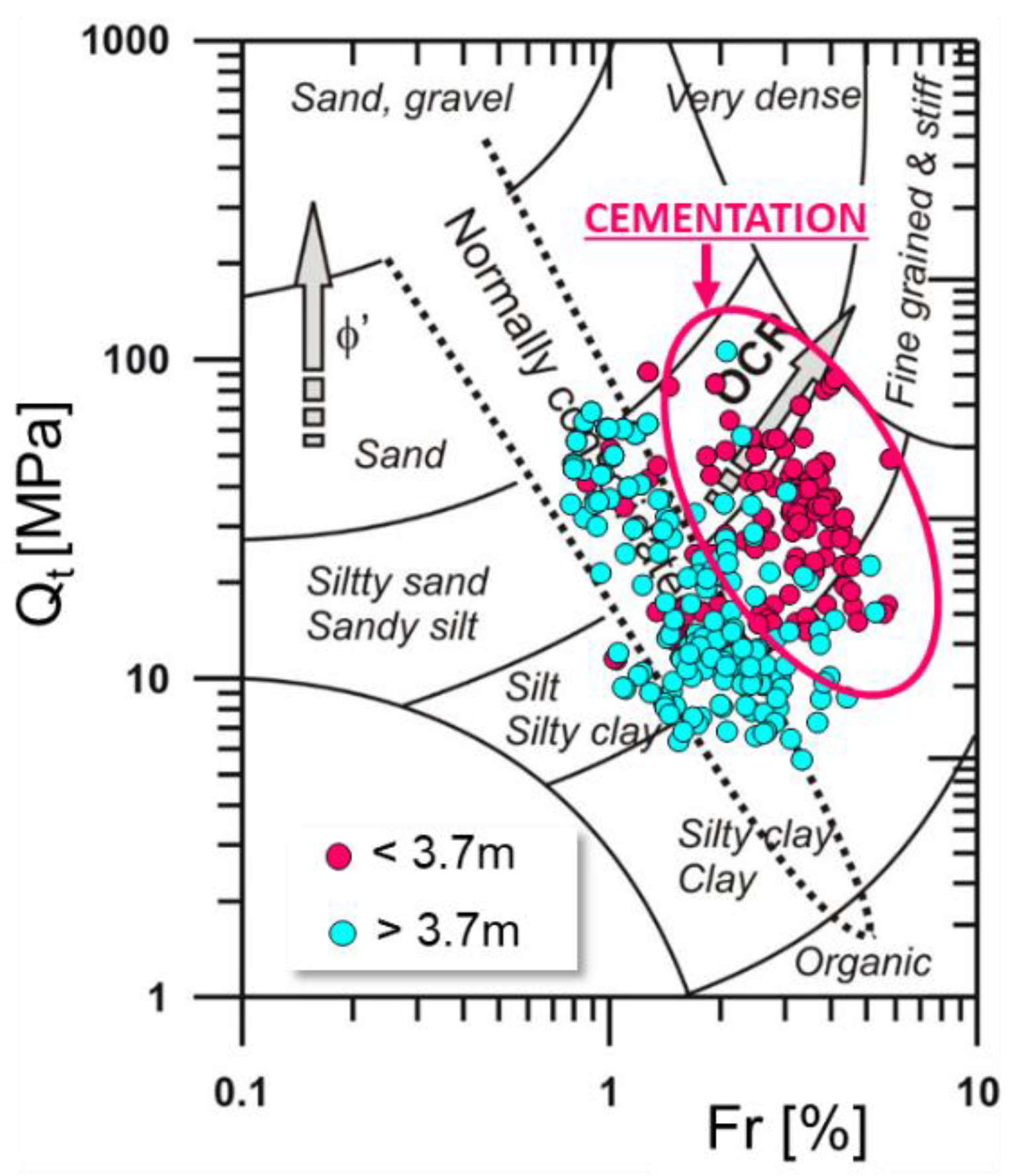
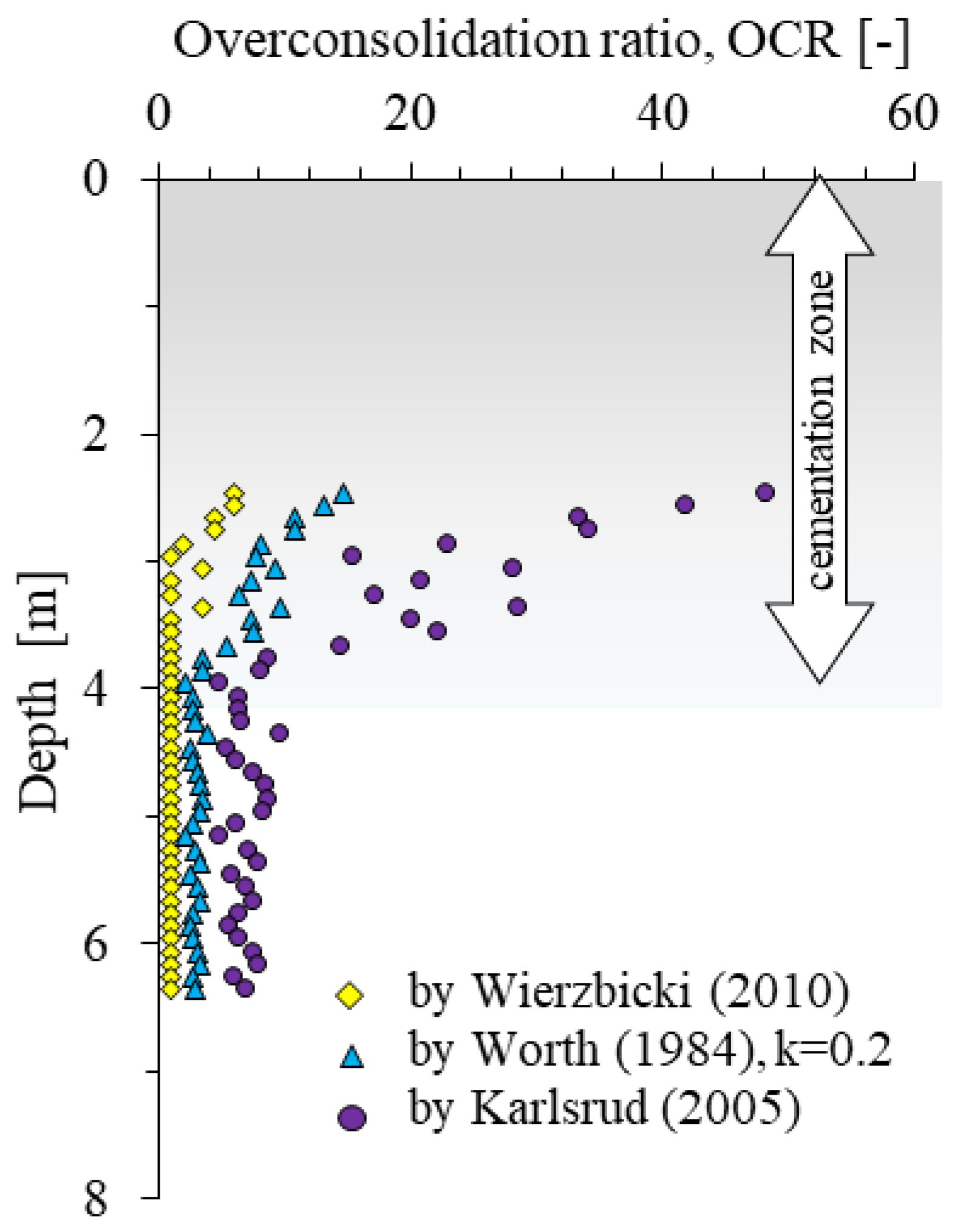
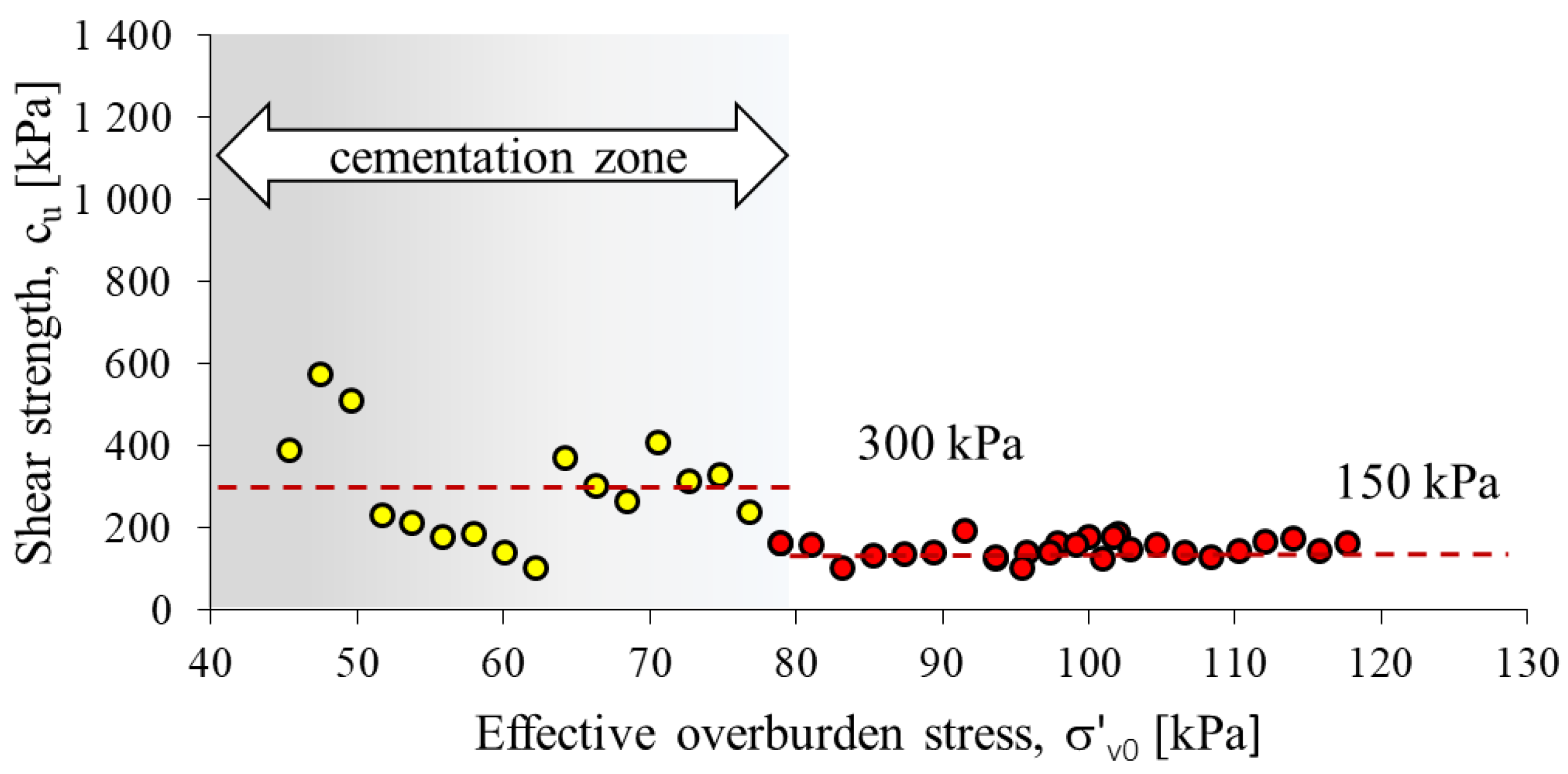


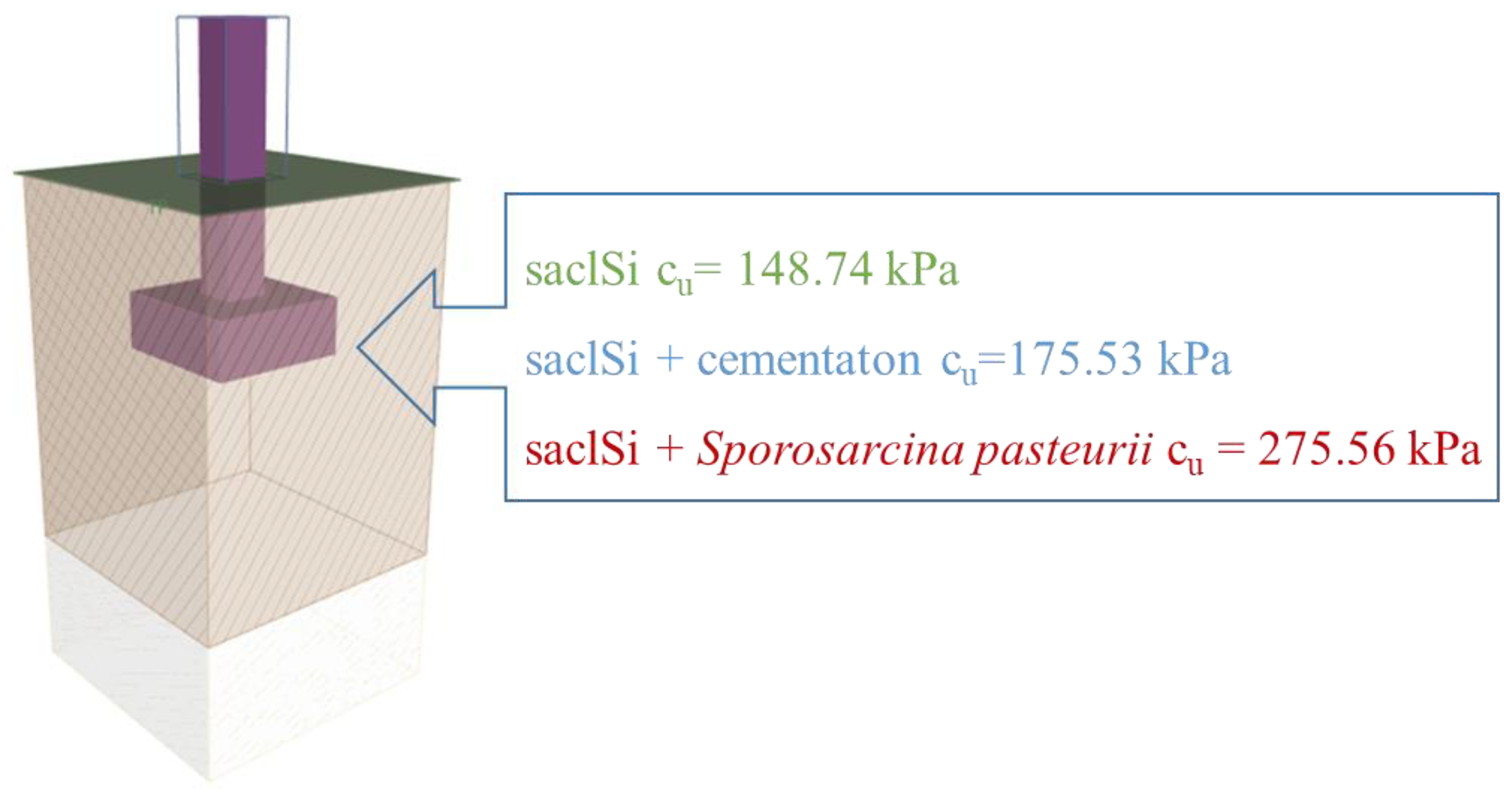

Disclaimer/Publisher’s Note: The statements, opinions and data contained in all publications are solely those of the individual author(s) and contributor(s) and not of MDPI and/or the editor(s). MDPI and/or the editor(s) disclaim responsibility for any injury to people or property resulting from any ideas, methods, instructions or products referred to in the content. |
© 2023 by the authors. Licensee MDPI, Basel, Switzerland. This article is an open access article distributed under the terms and conditions of the Creative Commons Attribution (CC BY) license (https://creativecommons.org/licenses/by/4.0/).
Share and Cite
Stefaniak, K.; Wierzbicki, J.; Ksit, B.; Szymczak-Graczyk, A. Biocementation as a Pro-Ecological Method of Stabilizing Construction Subsoil. Energies 2023, 16, 2849. https://doi.org/10.3390/en16062849
Stefaniak K, Wierzbicki J, Ksit B, Szymczak-Graczyk A. Biocementation as a Pro-Ecological Method of Stabilizing Construction Subsoil. Energies. 2023; 16(6):2849. https://doi.org/10.3390/en16062849
Chicago/Turabian StyleStefaniak, Katarzyna, Jędrzej Wierzbicki, Barbara Ksit, and Anna Szymczak-Graczyk. 2023. "Biocementation as a Pro-Ecological Method of Stabilizing Construction Subsoil" Energies 16, no. 6: 2849. https://doi.org/10.3390/en16062849
APA StyleStefaniak, K., Wierzbicki, J., Ksit, B., & Szymczak-Graczyk, A. (2023). Biocementation as a Pro-Ecological Method of Stabilizing Construction Subsoil. Energies, 16(6), 2849. https://doi.org/10.3390/en16062849







